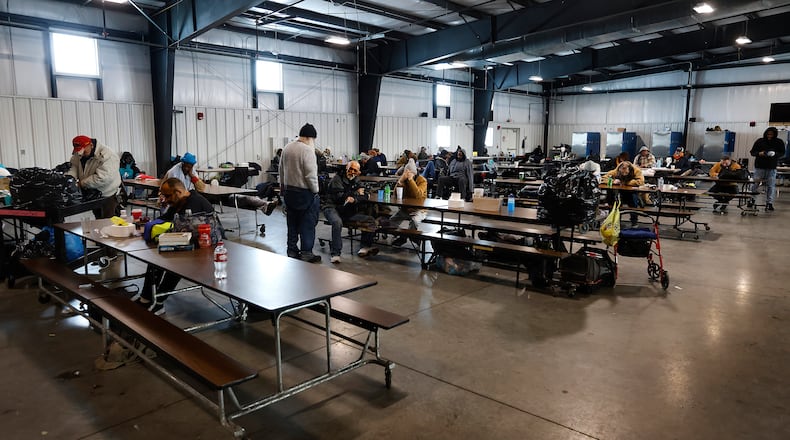The operator of the Gettysburg Gateway Shelter for Men and some men staying there agree the shelter is in a terrible location, too far from supportive services, and the conditions inside are crowded and chaotic. St. Vincent De Paul Society, Dayton says they plan to cease operations there and is calling for a new approach to addressing local homelessness.
But as one of the largest and busiest men’s shelters in the state, the Gettysburg facility provides lifesaving warmth and housing to hundreds of men who have nowhere else to go.
New data show that more than 200 people stayed at Dayton’s homeless shelter for men nearly every day last year.
“There’s just too many people,” said James Potter, 61, who has been living at the men’s shelter for about six months. “I don’t like it one bit.”
Shelter operator St. Vincent de Paul Society, Dayton, is going to cease operations at the facility in about six months. The nonprofit’s leadership say the current shelter likely is not financially viable and a new model is needed to better serve homeless men.
Officials with the city of Dayton, Montgomery County and other local organizations say they are working to find a new operator for the current facility.
Michael Vanderburgh, executive director of St. Vincent de Paul Society, Dayton, said he worries that there is a lack of urgency to develop a succession plan and a new strategy to better serve this population.
“July 1 will come very fast, and we don’t have any time to lose,” he said. ““We know that homeless men will be better served if they are not served at the Gettysburg location. ... We want the best for these men.”
Conditions
The Gettysburg Gateway Shelter for Men on average sheltered about 229 men every day last year, according to a Dayton Daily News analysis of data from St. Vincent de Paul Society, Dayton. The men’s shelter on average served about 253 daily guests in 2023 and 234 in 2022.
There were only 12 days last year when the daily guest count dipped below 200 people.
St. Vincent de Paul Society is in charge of the Gettysburg Gateway Shelter for Men at 1921 S. Gettysburg Ave. in southwest Dayton and the Shelter for Women and Families at 120 W. Apple St., just south of downtown. Each shelter has about 250 beds and about 50 sleeping mats.
St. Vincent de Paul says sheltering more than 200 men every night at the Gettysburg Gateway Shelter is difficult and expensive. The nonprofit late last year announced it can no longer afford to run the facility and will quit operations on June 30.
St. Vincent de Paul Society will continue to be in charge of the Shelter for Women and Families, plus other facilities that offer supportive and transitional housing to homeless men.
In addition to beds and mats, St. Vincent de Paul also provides three meals a day, laundry services and personal items such as toiletries and clothing for guests.
Facility issues
Potter, who has been staying at the shelter since last summer, said living alongside a couple hundred people is chaotic, there are arguments all the time and people get possessive and angry about their seats and personal space.
He said there are lots of people who struggle with mental illness who are noisy and act erratically and cause disturbances.
Potter said there aren’t enough caseworkers for people to get the kind of individualized care they need. He said he can’t leave the shelter until he has a source of income, and he’s not had the assistance he needs to get his life back on track.
“I’m pretty much stuck right now,” he said.
St. Vincent de Paul opened the men’s shelter about 15 years ago in what used to be a city jail. The complex, previously called the Dayton Rehabilitation Center, was known as “the workhouse.”
The shelter still feels like a jail. The sleeping areas are jail pods, and there are still guard stations.
Shelter guests who maintain outside employment and demonstrate good behavior can be rewarded with their own rooms, which are cells that were once used for punishment and solitary confinement.
Location, other concerns
There are very few places within a short walk of the shelter — mainly just two gas stations and a Family Dollar store. A new store, Gettysburg Grocery, will officially open at 811 S. Gettysburg Ave. Monday, but it is a bit of a hike from the shelter.
There are bus stops on Gettysburg Avenue about a quarter mile to a mile from the front door of the shelter.
The shelter is in a part of the city that has undesirable facilities like the landfill, a wastewater treatment plant and multiple correctional centers.
The men’s shelter until about 2009 was at Apple Street, near downtown, back when it was called the St. Vincent Hotel.
Potter said he thinks the men’s shelter was moved to South Gettysburg Avenue because the community wanted homeless men out of sight, out of mind.
“There’s nothing to do around here,” Potter said. “They don’t want us downtown ... ‘Put the homeless people somewhere else — take them to the wilderness and drop them off.’”
Some men say shelter life is pretty depressing and there’s not much to do other than sit around or sleep or watch TV.
Gary Blake, 65, a longtime volunteer at the men’s shelter, said the St. Vincent Hotel, near downtown, was overflowing with people because it did not have enough space.
Blake said the Gettysburg facility kind of has the opposite problem — the complex is so big that it’s hard to maintain and has lots of wear and tear because it can and does house such a large number of people.
“Whoever comes in here after St. Vincent needs to come in with a model that takes those things into consideration,” he said. “I think it should go well but it will need to be resized quite a bit. This is a big facility — it used to be a jail — and it’s probably not the best layout and operation for the guys.”
“The guys need some semblance of normalcy,” he said. “Your heart breaks for these guys.”
What’s next
Dayton and Montgomery County officials have said they will ensure there are emergency shelter services for men in the community, and they are looking for a new shelter operator to provide a smooth transition for clients.
The county released a request for information to gauge initial interest in new operators for the men’s shelter, and a bidders’ conference was recently held, with applications due back on Jan. 22, said Erin Ritter, Dayton’s human services manager.
A request for proposals is expected to be released in the near future.
“We will review all applications that are submitted and evaluate them based on multiple factors to determine who can best serve the men at the gateway shelter and ensure it is open and staffed 24 hours a day, seven days a week, 365 days per year, including all holidays,” Ritter said.
Some people say they’ve had a good experience at the shelter, like 62-year-old Gary Bailey, who has been living there about six months.
He said he has no major complaints, and shelter life is what you make it.
“I’m just starting over and trying to get my life back together,” said Bailey, who is from New York and plans to move back the Empire State as soon as he can.
‘We need new approaches’
Guests at the men’s shelter have lots of needs often related to substance abuse, mental illness, disabilities, medical conditions and age-related challenges, said John Hunter, St. Vincent de Paul Society’s chief of operations.
He said community members and partners need to have in-depth discussion about what kind of facilities and services would best serve this vulnerable population moving forward.
“When you put all of that together, it really creates a challenge to meet all of those needs under one roof,” Hunter said. “You can’t do those things very well because you’re too watered out.”
With no services nearby, the Gettysburg facility is not a good place for the men’s homeless shelter, Hunter said.
Hunter said he thinks it makes more sense to have a few smaller facilities because they’d likely be more manageable and less chaotic. He thinks smaller settings could offer individualized services that would help improve outcomes for people experiencing homelessness.
Hunter also said that facilities with a large number of beds draw unhoused people from other communities, which strains local resources.
Usually, about a quarter to one-third of guests at the men’s shelter come from outside of Montgomery County.
St. Vincent Executive Director Vanderburgh said he thinks there are a variety of other sites across the city that would be a more suitable location for the shelter, including in and around downtown.
Vanderburgh, however, said he realizes there undoubtedly would be “NIMBY” pushback from prospective neighbors. NIMBY stands for “not in my backyard.”
Vanderburgh said sheltering homeless men is a community responsibility, and no one group or agency can handle the task alone.
“We need new approaches and new organizations and new churches and new individuals at the table to talk about ... what they can do to meet this challenge,” he said. “This is watershed moment.”
Christopher Snyder, who’s been at the shelter for weeks, said life inside is pretty tough.
He said he has a sinus infection and he is sick for the first time in a very long time, because illness spreads rapidly in that congregate setting.
Snyder said he has scoliosis, arthritis and slipped discs and he doesn’t get to lay down as much as he needs to. He also said his body can not handle a long walk up the hill on Gettysburg Avenue to visit the gas station or dollar store.
Snyder said he had nowhere to go when he was evicted from his home in a Middletown trailer park late last year. He said the shelters in and around Middletown and Hamilton were full, and Dayton’s facility was his only option.
“I appreciate the help — I didn’t have any other choice and they took me in and I’m grateful for that,” he said.
About the Author








